Shrinkage was modelled using a simple moisture volume displacement and incorporated into an existing two layer diffusion drying model. The resulting combined model was tested using shrinkage and drying data for banana slices (approximately 5 to 9 mm thickness) from three sets of conditions measured in replicate, over a range of conditions from 28-38°C and 12-30% relative humidity, using a heat pump dryer. Experiments for carrot were conducted at the same drying conditions for three different slice thicknesses: 3, 5 and 8 mm. The shrinkage model provided better agreement for carrot than for banana, but both were considered adequate fits and so the model was included in the drying rate equation. Parameters for the combined model were estimated by regression. It was found that on average, the prediction of the shape of the moisture-time drying curves was improved by inclusion of shrinkage in the two layer model, as the R² values of the model for banana and carrot increased by 9% and 14% respectively. The results confirmed that product shrinkage affects moisture transfer, and should be included in predictive model development.
Keywords: Shrinkage, Drying, Moisture Diffusion
*Corresponding author:
E-mail: bithika.saha@unsw.edu.au
Saha*, B. ., Jiang, C. ., Arcot, J. ., & Driscoll, R. . (2018). Incorporation of Shrinkage into Two Layer Diffusion Model for Air Drying. CURRENT APPLIED SCIENCE AND TECHNOLOGY, 245-257.
